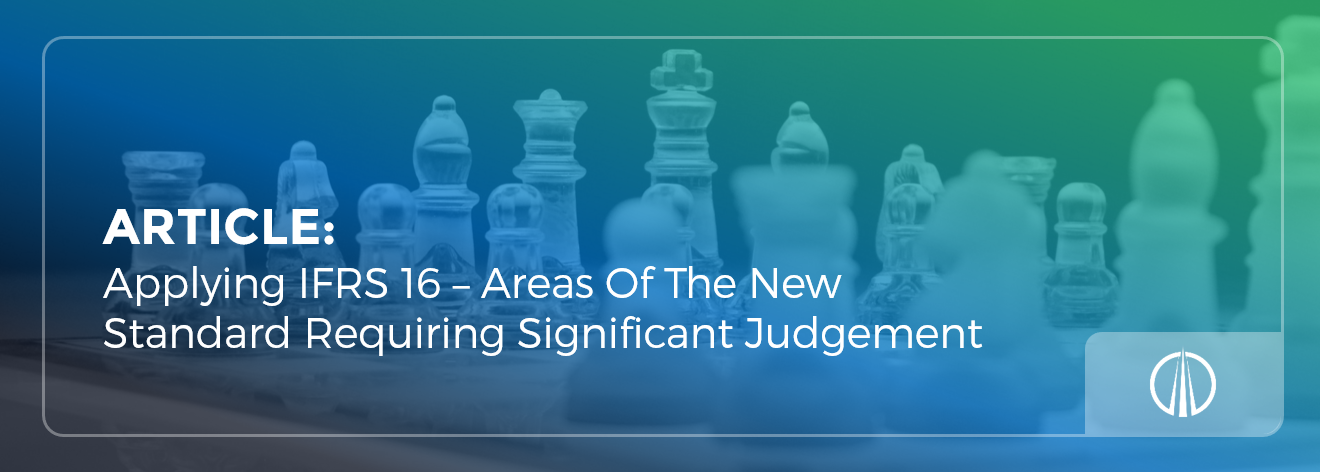Applying IFRS 16 – Areas Of The New Standard Requiring Significant Judgement
Updated 12th May 2021 | 6 min read Published 23rd August 2018


It may be a slight exaggeration but generally, all businesses whether in the private or public sectors use leasing as a means to acquire the use of assets and/or property in their operations. And with this in mind, the IASB and FASB have been attempting to draft, design and develop a standard for recognising the asset and any associated financial liabilities now or in the future. In 2016 the standard in the form of IFRS 16 was issued by IASB and as FAS 13 (update ASC842) by FASB.
Recognising the Need for Transparency
The publication of the new standards was the culmination of a move to make the accounting for leases more transparent – by this, we essentially mean that leases previously treated as operating leases under FASB 13 and IAS 17 would now generally be accounted for in the same manner as finance type leases.
In looking at identifying leases then you may wish to reference the Innervision blogs – “Applying IFRS 16 - identifying your business leases”.
The key point is that under IAS 17 the test of whether leases “transfer substantially all the risks and rewards incidental to ownership” defined a finance lease transaction versus operating lease whilst now under IFRS 16 treatment moves away from the whole asset and centres on the rights of use of the asset to the lessee – not the value of the asset or its lease costs.
Significant Judgement Required
Undoubtedly the adoption of IFRS 16 will require businesses to make a number of decisions and require the exercise of judgement, particularly around the areas of valuing the lease element of any service or product agreement and deciding if any exemption is permitted, desirable and warranted and secondly around the area of optimising the resultant financial reporting.
Under IFRS 16 the new standard defines a lease as “a contract, or part of a contract that conveys to the customer the right to use an asset (the underlying asset) for a period of time in exchange for consideration”.
- As a lessee, you must have an identifiable asset made available to you under a contract and
- You must have the right to control that asset – by this, we mean that you have the “right of use” and can accordingly not just direct its use but also substantially reap all of the financial benefits resulting from its use over the course of the lease period.
Clearly in the case of leasing a tractor unit and trailer then the lessee enjoys the “right of use” for the period of the lease where and whenever it chooses. The lease though will dictate that at the end of the period the lessor then regains the rights associated with the asset and its use.
IFRS 16 is further proscriptive in what “assets” or “right of use assets” can be treated as a leased asset in excluding many “rights” particularly those relating to mineral exploration, biological assets, licensing agreements, patents and copyrights. In the case of other intangible assets then treatment under IFRS 16 will require the standard to be applied in full or for the intangible asset to be expensed.
Some of the judgements that you as a lessee will have to make will include:
- Significant judgement will be required when identifying or determining if a contract is or contains a lease. This is due to the new definition of a lease under the new standard.
- Determining whether as a lessee you are reasonably certain that you will exercise an extension or termination option will also require considerable judgement.
- in any committed contract, you will need to break out and evaluate any substantial service element – the non-leased components as opposed to lease components. However, an optional practical expedient exists that permits lessees to make an accounting policy choice, by class of underlying asset, not to separate lease and non-lease components and alternatively, account for each lease component and any associated service component together as a single lease component. Judgement will be required to determine if the policy election will be applied.
- for agreements with low-cost assets, the guideline is <$5,000 when new, will you expense or capitalise them. You can decide on a lease by lease basis and as such you could be accounting for the same type of asset or assets with different treatments.
- treatment of short-term lease agreements – any commitment made initially for less than one year can, provided no purchase option exists, be treated using the simplified accounting. However, you must apply the same exemption to all similar asset classes under short-term agreements.
- if an existing operating lease, at time of adoption, has less than 12 months to run then you may want to treat it as a short-term lease.
- quantifying the economic incentives with options to cancel or renew will further guide you in how the lease should be treated.
- looking at your operating lease portfolio you will need to decide how to value your assets – either via your carrying cost recalculated from date of commencement using the incremental borrowing rate at the date of initial application or by applying an amount equal to outstanding liabilities at the time of adoption.
- which interest rate to apply to obtain the present value of the rentals – the incremental borrowing rate or the implicit interest rate. The choice may depend on the information available (particularly at commencement date), lease length (only a part of the economic life of the asset) and asset type (particularly property). Any decision here will likely have an impact on an entity’s financial statements.
- presentation of the leased assets and associated liabilities. You are required to detail separately leased assets from non-leased assets and similarly the associated liabilities. You may choose to detail the separation in the primary accounts or in the notes to the accounts (in which case the leased assets are in the same line as the owned assets.
- when and how will you alert those parties with a real interest in your financial position (lenders, lessors, stakeholders, investors and potential investors etc) as to the impact on the financial position that the adoption of the standard may make – particularly if you have many operating lease commitments.
Engaging with Auditors will be Essential
It should be noted that you do not necessarily need to justify your judgement decision regarding the expedients as these are made available under the standard. You will though want to discuss the options and why you may wish to make one judgement over another with your external auditors and all interested internal parties, especially concerning key judgements that can have a significant impact on an entity’s financial statements and in instances where the standard includes only limited guidance on how to interpret the term – do this at the earliest opportunity to avoid the wrong or less productive path.
Finally, do remember that if you can make these judgements and utilise Innervision’s LOIS Lease Accounting software solution then the necessary accounting treatments are done for you today and going forward – contact us for a demo.
When transitioning to the new accounting standards, there are many complex decisions and elections that companies will have to consider through the implementation process. Download a free copy of our 7 Step Guide to Lease Accounting Compliance to find out all you need to know about the new standard and how to prepare for it.
Disclaimer: this article contains general information about the new lease accounting standards only and should NOT be viewed in any way as professional advice or service. The Publisher will not be responsible for any losses or damages of any kind incurred by the reader whether directly or indirectly arising from the use of the information found within this article.





